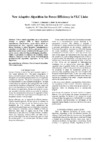Please use this identifier to cite or link to this item:
https://accedacris.ulpgc.es/jspui/handle/10553/107075
| DC Field | Value | Language |
|---|---|---|
| dc.contributor.author | Rabadán Borges, José Alberto | en_US |
| dc.contributor.author | Guerra Yánez, Víctor | en_US |
| dc.contributor.author | Rufo Torres, Julio Francisco | en_US |
| dc.contributor.author | Pérez Jiménez, Rafael | en_US |
| dc.date.accessioned | 2021-05-03T09:02:51Z | - |
| dc.date.available | 2021-05-03T09:02:51Z | - |
| dc.date.issued | 2018 | en_US |
| dc.identifier.uri | https://accedacris.ulpgc.es/handle/10553/107075 | - |
| dc.description.abstract | Power control algorithms are a well-known strategy to optimize SNR in highly interfered environments. Furthermore, sensor nodes, which are battery-powered, have expensive replacement costs. Hence, strategies to reduce the power consumption are mandatory in this kind of device, and power control algorithms can be energy-optimized. In this paper, a new power control, Adaptive-Step-and-Damping algorithm - ASDA- is presented. It enhances the resulting energy efficiency compared with the classic Newton-Raphson gradient-descent algorithm (equivalent to an LMS algorithm) | en_US |
| dc.language | eng | en_US |
| dc.publisher | Institute of Electrical and Electronics Engineers (IEEE) | en_US |
| dc.source | 14th International Wireless Communications and Mobile Computing Conference (IWCMC), p. 684-689 | en_US |
| dc.subject | 3325 Tecnología de las telecomunicaciones | en_US |
| dc.subject.other | Energy efficiency | en_US |
| dc.subject.other | Power Control Algorithm | en_US |
| dc.subject.other | VLC isolated nodes | en_US |
| dc.title | New adaptive algorithm for power efficiency in VLC links | en_US |
| dc.type | info:eu-repo/semantics/conferenceobject | en_US |
| dc.type | ConferenceObject | en_US |
| dc.relation.conference | International Wireless Communications and Mobile Computing Conference (IWCMC 2018) | en_US |
| dc.investigacion | Ingeniería y Arquitectura | en_US |
| dc.type2 | Actas de congresos | en_US |
| dc.utils.revision | Sí | en_US |
| dc.date.coverdate | JULIO 2018 | en_US |
| dc.identifier.ulpgc | Sí | en_US |
| dc.contributor.buulpgc | BU-TEL | en_US |
| dc.description.ggs | 3 | |
| item.fulltext | Con texto completo | - |
| item.grantfulltext | open | - |
| crisitem.author.dept | GIR IDeTIC: División de Fotónica y Comunicaciones | - |
| crisitem.author.dept | IU para el Desarrollo Tecnológico y la Innovación | - |
| crisitem.author.dept | Departamento de Señales y Comunicaciones | - |
| crisitem.author.dept | GIR IDeTIC: División de Fotónica y Comunicaciones | - |
| crisitem.author.dept | IU para el Desarrollo Tecnológico y la Innovación | - |
| crisitem.author.dept | GIR IDeTIC: División de Fotónica y Comunicaciones | - |
| crisitem.author.dept | IU para el Desarrollo Tecnológico y la Innovación | - |
| crisitem.author.dept | GIR IDeTIC: División de Fotónica y Comunicaciones | - |
| crisitem.author.dept | IU para el Desarrollo Tecnológico y la Innovación | - |
| crisitem.author.dept | Departamento de Señales y Comunicaciones | - |
| crisitem.author.orcid | 0000-0002-9994-4495 | - |
| crisitem.author.orcid | 0000-0002-6264-7577 | - |
| crisitem.author.orcid | 0000-0002-2269-6729 | - |
| crisitem.author.orcid | 0000-0002-8849-592X | - |
| crisitem.author.parentorg | IU para el Desarrollo Tecnológico y la Innovación | - |
| crisitem.author.parentorg | IU para el Desarrollo Tecnológico y la Innovación | - |
| crisitem.author.parentorg | IU para el Desarrollo Tecnológico y la Innovación | - |
| crisitem.author.parentorg | IU para el Desarrollo Tecnológico y la Innovación | - |
| crisitem.author.fullName | Rabadán Borges, José Alberto | - |
| crisitem.author.fullName | Guerra Yanez, Victor | - |
| crisitem.author.fullName | Rufo Torres,Julio Francisco | - |
| crisitem.author.fullName | Pérez Jiménez, Rafael | - |
| crisitem.event.eventsstartdate | 25-06-2018 | - |
| crisitem.event.eventsenddate | 29-06-2018 | - |
| Appears in Collections: | Actas de congresos | |
Page view(s)
137
checked on Mar 1, 2025
Download(s)
56
checked on Mar 1, 2025
Google ScholarTM
Check
Share
Export metadata
Items in accedaCRIS are protected by copyright, with all rights reserved, unless otherwise indicated.
